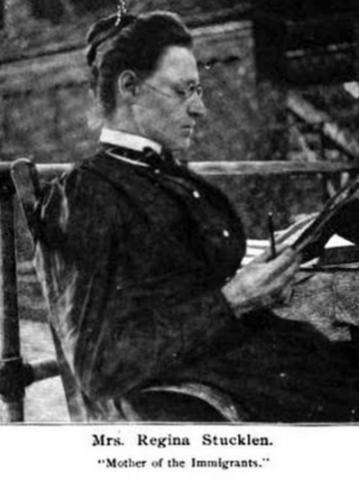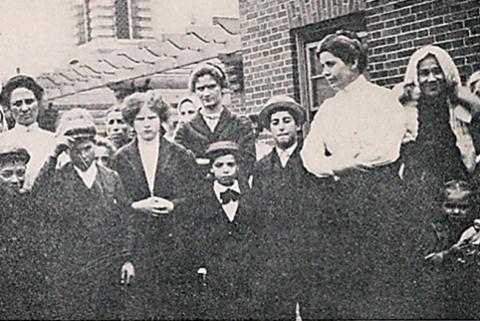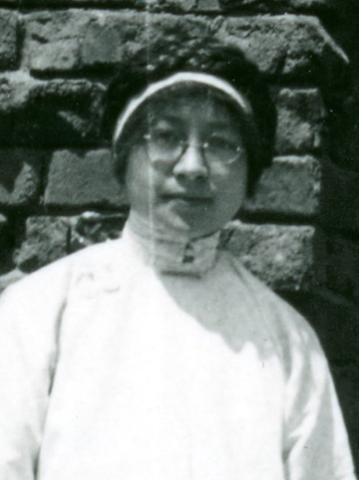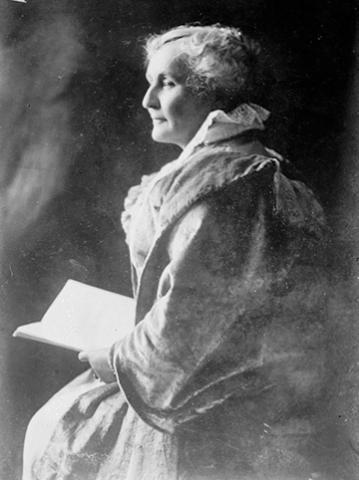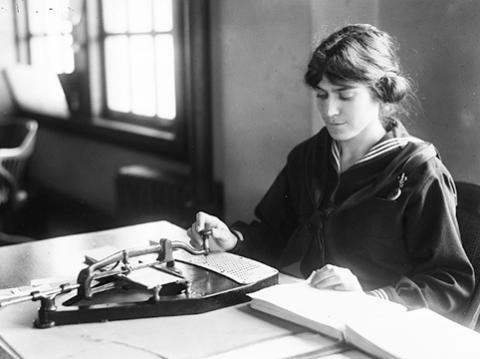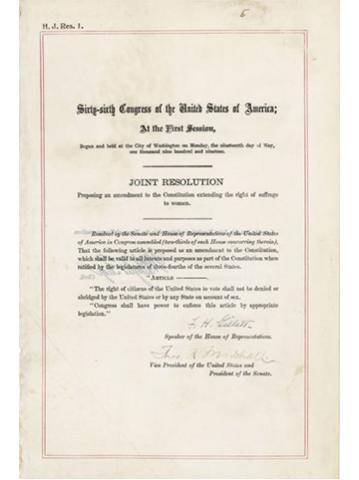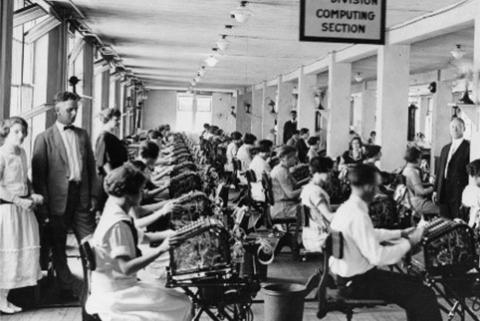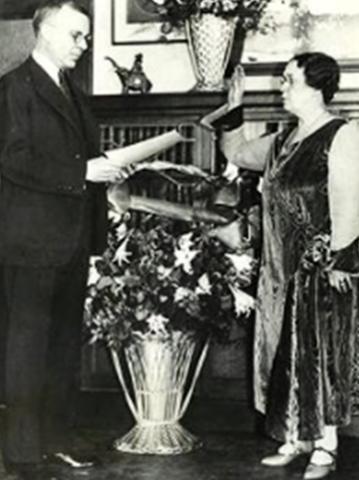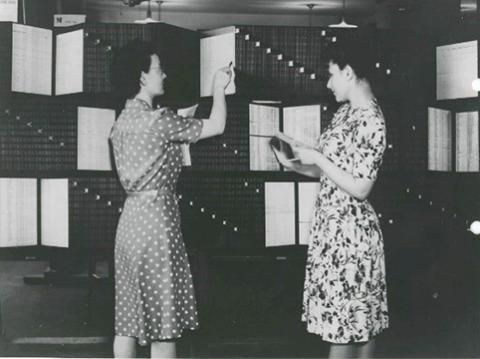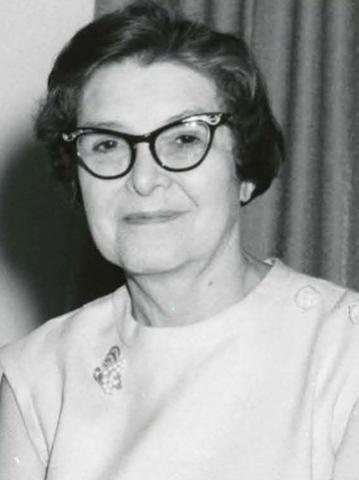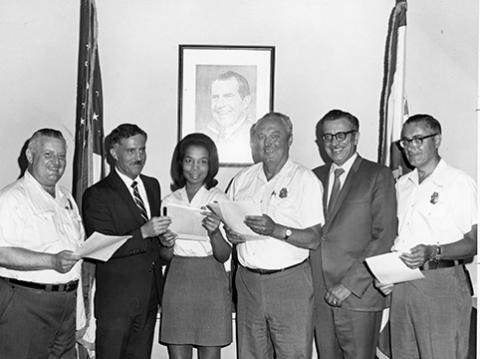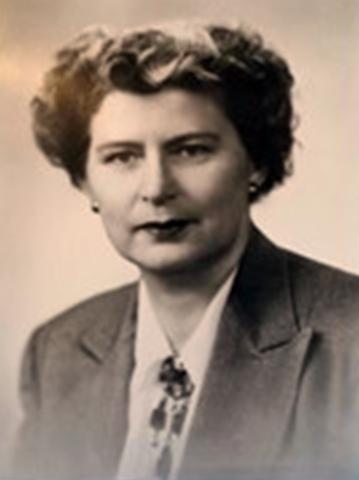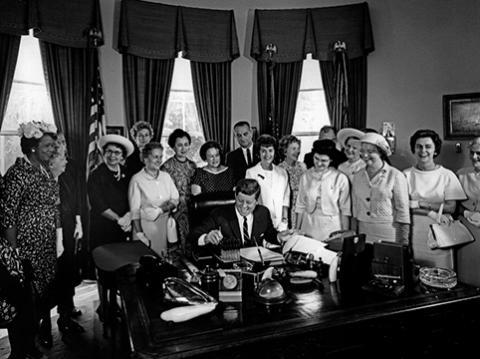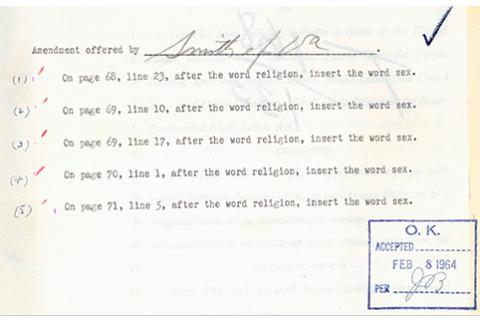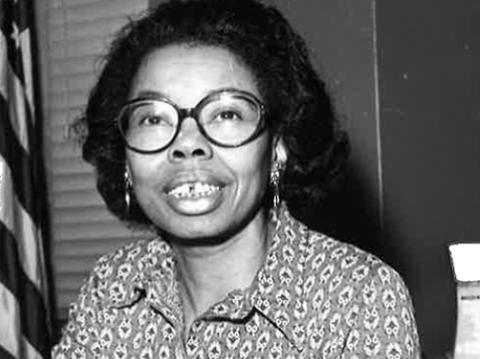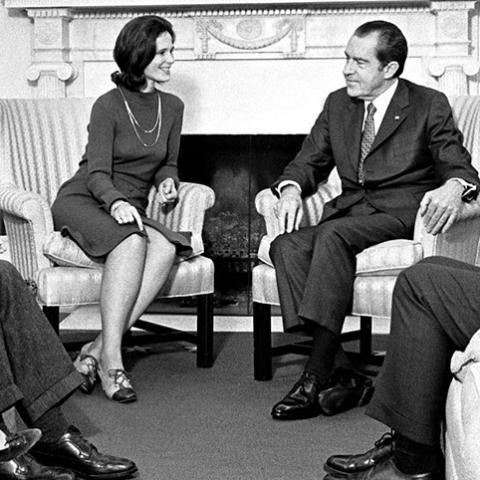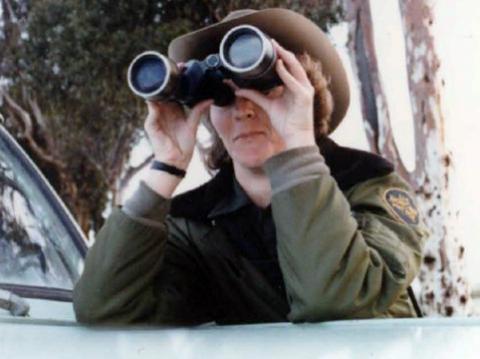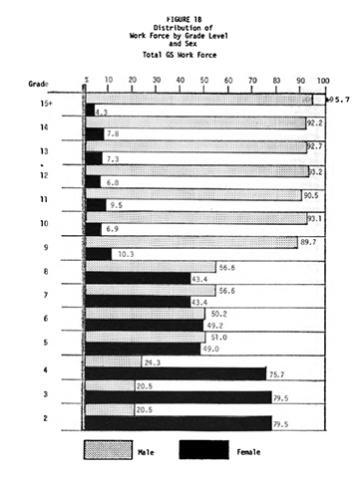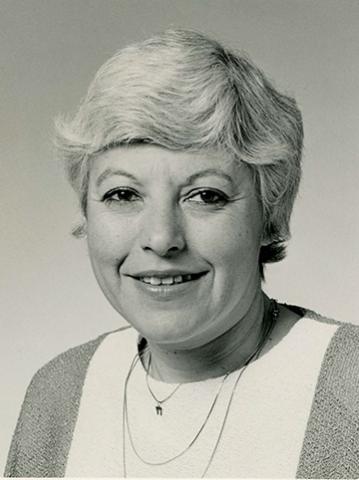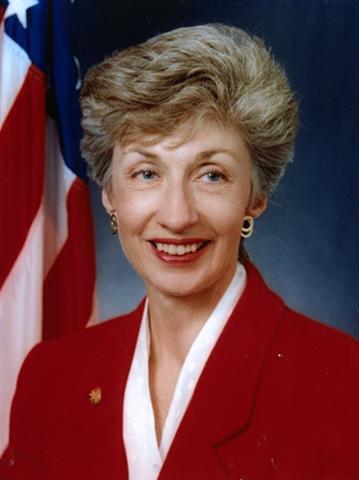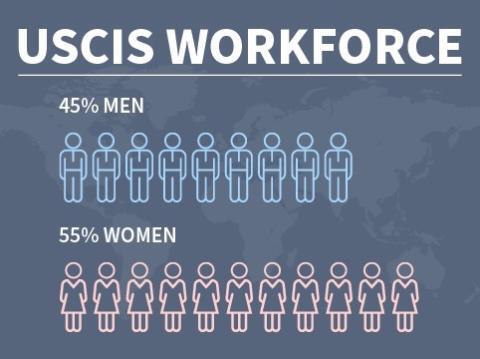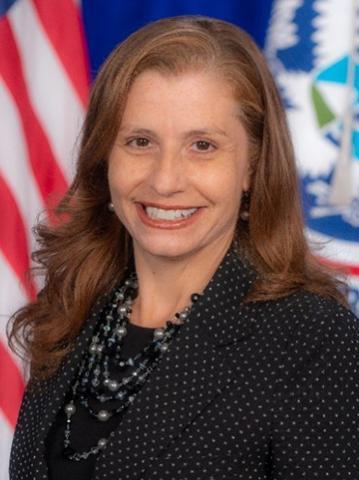History of Women in Federal Immigration and Naturalization Service
When Congress created the U.S. Immigration Bureau in 1891, few women had the right to vote, and many people believed a woman’s place was in the home. In 1893, only 16 women worked for the immigration service, most as cleaners and laundrywomen. Fast forward more than 130 years and approximately 55% of the agency’s workforce are women. In 2021, Ur Mendoza Jaddou was confirmed by the senate to become USCIS’ first permanent female director.
This timeline highlights more than a century of milestones for the women of the federal immigration and naturalization service. These women came from diverse backgrounds and made unique contributions, but they all overcame significant challenges and lit the way for others to follow.
-
Regina Stucklen served as one of the Immigration Bureau's first female "matrons" at Ellis Island when it opened. Her duties included helping women and children through the immigration process and supervising their care and oversight. Over time her responsibilities grew, and she led a small team of female employees. Stucklen spoke 7 languages and worked for state and federal immigration services for a combined 25 years.
Photo : Mrs. Regina Stucklen in Ainslee's Magazine, 1900
For more information, see: -
In 1893, the U.S. Immigration Service employed 16 women. They made up 9% of the total force. Ten years later, 57 women worked for the service and they made up 8% of the total force. Over this period, women’s salaries averaged $568, less than half of men’s, and most female employees worked as typists or performed manual labor.
Photo: Immigration matrons and their charges on the roof at Ellis Island, Popular Science, 1913
For more information, see: -
Tye Leung became the first Chinese-American woman to work for the U.S. government when she joined the Immigration Service. Born into a poor family in San Francisco's Chinatown in 1887, she received an education through free missionary schools. In 1910, she began work as a translator and assistant to the matrons at the Angel Island Immigration Station near San Francisco. There, Tye Leung met and fell in love with Charles Schulze, an immigration inspector of Scottish and German heritage. Because they were considered different races, their marriage was against California law. Afterward, both Tye Leung and Charles Schulze were reportedly pressured to resign from federal employment. Tye Leung continued her career in private industry, and she briefly served as a translator for the Immigration and Naturalization Service again in the 1940s.
Photo: Tye Leung in about 1908, photo courtesy of the California State Library
For more information, see: -
In the 1910s, Immigration Bureau agents enforced laws meant to prevent international sex trafficking. In 1914, the Immigration Service appointed activist and nonprofit leader Kate Waller Barrett as a Special Agent. She visited 16 countries to investigate conditions for women and formulated a report with specific suggestions. Afterward, the Immigration Service changed its policies to improve conditions for women in immigration detention. Barrett also worked with women's organizations internationally to try to ensure that women deported from the U.S. as prostitutes would not face punishment or homelessness in their nation of origin.
Photo: Kate Waller Barrett, courtesy of the Library of Congress.
For more information, see: -
During World War I, the federal government grew rapidly, and women received 75% of new civil service appointments in Washington, D.C., and 50% of such positions elsewhere. This resulted in an increase in women’s share of the federal work force from 1918 to 1940, when they held close to 1 in 5 federal jobs.
Photo: A female federal clerk worked a punch card machine, ca. 1915-23, courtesy of the Library of Congress.
For more information, see: -
After over 80 years of suffrage campaigns, women finally won the constitutional right to vote in 1919, resulting in the largest expansion of voting rights in U.S. history. However, restrictions on the state level prevented many women of color from voting. The Indian Citizenship Act of 1924 and the Voting Rights Act of 1965 finally provided the legal basis for equal voting rights to women of color across the country.
Image: Joint Resolution "Proposing an amendment to the Constitution extending the right of suffrage to women," courtesy of the National Archives and Records Administration (NARA).
For more information, see: -
This Classification Act of 1923 categorized federal job descriptions to try to create equal pay for equal work. However, because women made up the majority of low-paid clerical workers, the law did not bring true equality to men’s and women’s pay. By the 1920s, women held 90% of federal clerical positions. From the 1920s to the late 1930s, women made up an estimated 5% to 8% of professional positions within the federal government. Their specialties included statistics, education, libraries, and science.
Photo: A mostly female staff of federal employees performed clerical work, ca. 1920s-30s, courtesy of the Library of Congress.
-
In 1927, President Calvin Coolidge appointed Anna C. Tillinghast to serve as the nation’s first female district immigration commissioner. Before 1940, 3 other women served in this position: Mary Ward (Boston, 1934-40), Eliza B.K. Dooley (San Juan, Puerto Rico, 1934-40), and Marie Proctor (Seattle, 1934-40). These political appointments gave the women local prominence and the power to influence decisions in individual immigration cases. Their appointments marked an expansion of women’s duties in the federal immigration service from focusing narrowly on women’s and children’s issues to supervising large organizations with both male and female staff. However, these political appointees shared responsibility with administrators from the career civil service, and after 1940, the district immigration commissioner positions were phased out.
Photo: Anna C. Tillinghast taking the oath of office in 1931, photo courtesy of the Library of Congress.
For more information, see: -
Approximately 16 million men and 350,000 women served in the U.S. military during World War II. This massive mobilization created more opportunities for women to join the federal service. At INS’s wartime headquarters, women outnumbered men by more than 3 to 1. Some women hired during the war years earned supervisory positions and stayed in positions of authority after the war ended.
Photo: Women working with the Flex-o-line, an index to immigration and naturalization records, at the Central Office in Philadelphia, ca. 1942-48, from the USCIS History Office and Library Collection.
For more information, see: -
1945 - 1970
Helen Eckerson started as assistant chief of the Statistics Branch in 1941 and rose to chief in 1945. She stayed in that position until she retired in 1970. Eckerson and her largely female staff provided statistical analyses and reports to lawmakers that shaped significant legislation, including the Immigration and Naturalization Act of 1965 that made more immigrant visas available to Asian and African immigrants.
Photo: USCIS History Office and Library Collection
-
In the 1950s, air travel replaced sea travel as the most common method of entry for visitors to the U.S. The INS created a new corps of port receptionists to greet international travelers, help them assemble their paperwork, and guide them through immigration inspections and interviews at major airports. Requirements for the new hires included fluency in at least one foreign language, a college degree, and “proper bearing, manners, and appearance.” INS targeted the new positions for “pretty girls” who acted as assistants to immigration inspectors. While these positions paid little, over time many young women hired as port receptionists rose within the ranks of INS employees. Margaret M. Smith (left) is one example. Hired as a port receptionist in 1957, she rose to supervisory port receptionist in 1962, and by 1971 served as a supervisory immigrant inspector, a position that required managing and training male and female employees in INS policies and procedures.
Left: Margaret M. Smith (center), supervisory immigrant inspector, at an award ceremony for those receiving outstanding ratings for their work, ca. 1972, photo in the USCIS History Office and Library Collection
-
Lorraine Wall Hurney became the highest-ranking woman in the U.S. immigration service when she accepted the top management position for the INS district that covered Pennsylvania, Delaware, and West Virginia. In the 1930s, as a widow with three young children, she worked while attending law school at night. In 1941, INS hired her as an associate legal advisor and she rose to become an attorney in the General Counsel’s Office before being named district director in 1960. In 1966, she moved to Chicago, where she supervised the district that included Illinois, Wisconsin, and Indiana. Until her retirement in 1969, she was the only female district director in the country.
Photo: Lorraine Wall Hurney, image donated by family member.
-
The Equal Pay Act established women’s right to equal pay for equal work in private as well as public employment. The act made it illegal for employers to engage in separate and unequal hiring practices that offered women lower wages for performing the same job duties as their male counterparts. President Kennedy signed the bill into law and called it a first step toward greater equality for women.
Photo: President Kennedy signs the Equal Pay Act in June 1963, surrounded by female lawmakers and club leaders. Courtesy of the John F. Kennedy Presidential Library and Museum.
-
Several months after President Kennedy first introduced his sweeping civil rights bill, Rep. Howard Smith added an amendment to the act (pictured at left) to prohibit discrimination on the basis of sex. Representatives disagreed about whether this amendment might lead to the legislation’s defeat, but Reps. Martha Griffiths, Frances Bolton, and others campaigned to ensure the bill would keep the ban on sex discrimination. In 1964, the Civil Rights Act passed both houses of Congress and President Lyndon B. Johnson signed it into law. Title VII prohibited discrimination by private employers, labor unions, and employment agencies, and the law established the Equal Employment Opportunity Commission to enforce its provisions.
Photo: Courtesy of NARA.
For more information, see: -
Marjorie Jackson became the highest-ranking African American woman in the Department of Justice when she became assistant district director of citizenship at the New York District INS Office. Born in Kentucky, she earned a scholarship to Howard University and graduated from Brooklyn Law School in the top 5% of her class. She joined INS as an attorney in 1961. As assistant district director, Jackson managed 23 attorneys and the largest citizenship and naturalization office in the country. She promoted greater computerization at the agency and called for improved efficiency in the citizenship application process. When asked by the press if she supported “women’s lib”, she said, “I am not really much of a women’s lib adherent, but I believe women should be given an opportunity to advance. I have been given that opportunity in the Justice Department.”
Photo: USCIS History Office and Library collection.
-
The Equal Employment Act of 1972 empowered the federal Equal Employment Opportunity Commission to bring lawsuits against employers and unions who discriminated in the workplace, including local, state, and federal government agencies. This relieved the burden on victims of discrimination, who otherwise would have had to bring the civil lawsuits themselves. President Nixon supported the law and created a program to hire women at higher levels throughout the federal government.
Photo: President Nixon pictured with the first woman on the Council of Economic Advisors, Dr. Marina Von Neumann Whitman, photo courtesy of NARA.
For more information, see: -
The first 4 female graduates of the Border Patrol Academy met all the same qualifications as their male counterparts. Despite some who doubted them, the women shot, ran, and climbed walls in physical tests as well as the men in their class. At the time, Border Patrol was part of the larger INS; since 2003, it has been part of Customs and Border Protection.
Photo: Female Border Patrol agent, photo from the USCIS History Office and Library Collection
-
Women made up 36% of INS employees and 12% of the INS Officer Corps. The officers included: 10% of immigration inspectors and naturalization examiners, 1% of attorneys, 1% of investigators (special agents), and 0.25% of Border Patrol inspectors. Of the women at INS, approximately 24% were Black or African American, 12% were Hispanic or Latina, and 4% were Asian American. A U.S. Civil Rights Commission inquiry showed that women, especially women of color, predominated in the agency’s lowest-paid positions.
Photo: In federal employment, a higher “GS” level corresponds to higher pay and greater authority or expertise. Graph excerpted from Exhibit No. 5, Immigration Policy and Procedure Hearing Before the U.S. Commission on Civil Rights, Nov. 14-15, 1978, Vol. II, Exhibits.
-
When President Reagan’s administration asked Doris Meissner to serve as acting commissioner, she became the first woman to lead the agency, even temporarily. The daughter of immigrants, Meissner worked in non-profits before joining the Department of Justice in 1973. Though she was not an attorney, she rose to the position of deputy associate attorney general from 1977-81. Much of her work focused on immigration policy. At INS, Meissner held the top executive position for several months until the president appointed her successor, Commissioner Alan C. Nelson. Nelson hired Meissner as executive associate commissioner, the third-highest position in the agency, where she remained until 1986.
Photo: Doris Meissner (right) at a naturalization ceremony, from the USCIS History Office and Library collection.
For more information, see: -
INS selected Ruth Anne Myers out of a field of 15 to supervise its Phoenix-based district. Myers joined the INS at age 22 as a port receptionist—a role originally reserved for “attractive” and multilingual young women—and over the next 32 years rose to positions of increasing responsibility, including acting commissioner for the Southern Region and chief of staff for the INS commissioner in Washington, D.C. “I could have stayed at the places I have been or in the positions I have been in,” she said. “But I like change, challenges and more responsibility.”
Photo: USCIS History Office and Library Collection.
-
1993 - 2000
President Clinton named Doris Meissner to serve as commissioner of INS in 1993, making her the first woman to lead the agency. At the time of her confirmation, the press portrayed Meissner as a moderate who would help prevent illegal immigration. As commissioner, Meissner guided the agency through a period of growing immigration and political partisanship. INS doubled its workforce and tripled its budget; reduced wait times and backlogs in asylum and naturalization; and expanded computerization and digitization of immigration and naturalization processes. Meissner also attempted to tighten security at the borders following the first World Trade Center bombing.
Photo: USCIS History Office and Library Collection
For more information, see: -
Women made up 55% of the total USCIS workforce in 2020. White women composed 30% of the total workforce, followed by 11% Black or African American women, 7% Latina or Hispanic women, and 6% Asian American women. Less than 1% of the women working at USCIS identified as Native American, Hawaiian or Pacific Islander, or multiracial.
-
In August 2021, the Senate confirmed Ur Mendoza Jaddou as the first female director of USCIS. Jaddou served as chief counsel at USCIS from 2014-17 and then led DHS Watch, a project of the nonprofit America’s Voice, that focused on good governance and accountability in the immigration system. She received bachelor’s and master’s degrees at Stanford, as well as a J.D. from the University of California at Los Angeles. Jaddou’s father immigrated to the U.S. from Iraq, and her mother from Mexico. She grew up in Chula Vista, California.
Photo: USCIS History Office and Library collection.
For more information, see:

